What Website Pages Should You Link To From Your Small Business Emails
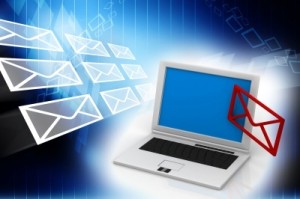
“Image courtesy of renjith krishnan / FreeDigitalPhotos.net”
Driving traffic to your website is the primary goal of any email marketing campaign. Deciding which web page to direct your audience to from your email can be a difficult decision. There are so many different options available that just one link may not seem enough, but at the same time too many links will seem like spam to your readers.
The best option is to consider two links in every email. This gives your audience flexibility and allows you two touch points to attract readers back to your website.
So what two website pages should you consider? Here is a list of some choices and their advantages and disadvantages.
Home Page
The most common option for small businesses is to include the homepage on their emails. The major problem with the home page is that it isn’t specific enough to give the reader any valuable interaction or you extra information on the customer. Relying on the customer to navigate your site to find something to process them further down the sales paths is wasteful. It is more likely they would look at a few non-specific pages or leave your site.
Contact Us Page
Email marketing is all about getting the audience to interact with you. Therefore, the contact us page sounds like the perfect option. It encourages readers to contact your sales team for them to close the deal.
Though, a contact page serves no real purpose in an email campaign. The contact details for your business can be easily included at the bottom of your email. Anti-spam laws across the world also insist your physical address is included on the email. Readers will not find a contact page enticing and they will only go there if they have a problem.
A Blog Post
One of the best aspects of an email campaign is the ability to deliver useful content to your potential customers. The information should be something which they find valuable and is actionable. That is why extending that information with content from your blog could be a good option.
It is a way to demonstrate your industry authority as well as encouraging audiences to read more of your content. The more they read of your content, the higher the chance they make a final decision about whether they will buy from you.
However, the blog post does little to help you progress the audience down the sales path. Therefore, while the blog post may be highly useful, it is more of a secondary link. It should perhaps be included in the text and used as evidence for statistics.
A Product Page
A product page is probably another highly used option on email campaigns. It certainly would allow for your audience to be pushed down the sales path and allow you to collect some instant revenue from the campaign.
However, if you push your contacts too quickly they may feel pressured into buying a product. This can cause them to unsubscribe, robbing you of a potential lifelong customer.
Landing Page
Creating a landing page and having a precise action upon it, allows you to collect specific information on what currently interests your contacts. This can then help you with list segregation and tailored emails to specifically target groups; increasing conversion rates and the return on investment for your email marketing.
Conclusion
There are several options for links from your email marketing campaigns. Each option is perfect for different audiences and careful thought is needed in what is right for your readers. Selecting the ideal web page can support your business in knowing what your customers want, processing leads and generating revenue.
Take Action:
- See what links your audience have been clicking through on previous emails.
- Select a link which you think is best for your audience and add it to your next email marketing campaign.
Read post Post a Comment. Tagged in: email linking, email marketing, Email Strategy, Small Business, website
Are Your Small Business Emails Optimized For Smartphones?
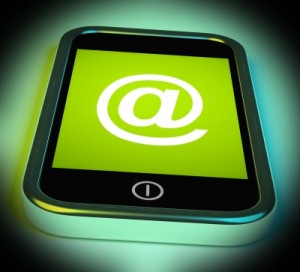
“Image courtesy of Stuart Miles / FreeDigitalPhotos.net”
Email marketing is constantly evolving. New trends are continuously being implemented allowing email to continue to be one of the most successful online marketing avenues. One of the current trends is the growth in emails being read on a Smartphone.
According to statistics, 90% of Smartphone owners will access the same email accounts from their device as their desktop and just under half of emails opened are viewed on a mobile device.
Emails opened on a Smartphone also have a higher percentage of unique clicks, and emails tend to be read for longer, even when compared to other mobile devices and desktops.
To take advantage of this trend you need to ensure that your email design is optimised so that it can be read on a Smartphone. Here are some of the design elements you can use to ensure this.
1. Restrict Your Use Of Images
Keeping your emails clear of excessive image use is an important aspect for mobile-optimized email campaigns. Using too many images means it takes longer for the email to load on the phone and the potential customer will click off your email before they’ve read it.
Use one relevant image for the email. Ensure that it is not too big either, or you’ll suffer the same problem.
2. Have a Responsive Template
If you are using a predesigned template, then make certain the design is responsive. A responsive design will automatically adjust the view so it fits the screen it is being viewed upon, whether a desktop, tablet or Smartphone.
3. Watch Your Words
Some phones will only display a certain length of the subject line. Therefore you have to ensure your subject line is less than 30 characters. If you have to have a longer title, make the key components of the title within those first few characters.
Some phones will also give more priority to the “from” label. There is little you can do about this apart from to make sure your emails are being sent from an email address which has a name attached to it. Sending emails from a Sales@ or customerservice@ often get opened less, no matter what device is currently being used.
4. Body Text
The body of your email also needs special attention paid to it. Shorter paragraphs are easier for the reader to digest and because your reader is likely to be on the go, have the key points mentioned at the very beginning. Otherwise your message could be forgotten when they are distracted by something going on around them.
5. Linking
Links on phones can look rather clumsy. Reduce the amount of links to just two. These links should not be close together as this can be distracting and reduce the click-through rate.
6. Use Buttons
Because most Smartphones have touch screens; create links to content using buttons rather than in-text hyperlinks. This is far easier for the user to select the link they want. To aid this, have significant space around the button to avoid the user clicking upon the wrong item.
7. Link To Mobile Friendly Websites
Any link needs to direct the reader to a mobile friendly site. Otherwise your reader will be disappointed with a poor looking site and will take no further action with your brand.
Conclusion
Having a mobile friendly email is not a difficult task, keep elements simple and strip down most of the advanced features that were once a trend. A quality email designed for mobile, with the rise of users accessing their emails online, will allow you to achieve more from your campaigns.
Take Action:
- Have a look at your last few emails and see if there are improvements you can make to ensure your emails are Smartphone friendly.
- Test your new email design to see how it looks on a Smartphone.
Read post Post a Comment. Tagged in: email design, email marketing, Email Newsletters, mobile emails, Small Business
Who Should Manage Your Small Business Email Newsletter?

Image courtesy of Stuart Miles / FreeDigitalPhotos.net
Running a small business email newsletter campaign can be challenging as there are several responsibilities other than simply clicking send for each marketing message. That is why some businesses outsource their email marketing to services which specialise in this style of marketing.
For some, outsourcing is not an option and instead they have to manage the email marketing in-house. There is also the option of going hybrid and having some of the email marketing handled by a service provider and some in-house. Here is a breakdown of each option, their advantages and disadvantages and how you can get the most out of each method to generate your email marketing content.
Fully In-house
In-house development of your email marketing campaign certainly has its benefits. The fact that you have someone on the inside of your business creating and sending out your mail allows you to maintain your brand’s voice and therefore your entire marketing is aligned! This can often be a factor in the long term success of conversions. This method can also offer substantial savings, yet that doesn’t always mean cost effectiveness.
On the other hand, there are problems. Unless you hire someone to maintain your email marketing full time then you are going to be doing the work yourself or have a member of your staff do it who has other responsibilities. This can cause problems in busy times when they don’t have the necessary time to offer proper maintenance of the email list.
This can result in missing email deadlines, something which could lead to the loss of email subscribers.
Another issue is that your staff member may not be the best writer, email designer or have another key skill missing. Any of these can affect the quality of your email and therefore cut your conversion rate down.
If you do go down this path it is important that you do several things to ensure the best quality:
1. Hire someone who has experience in writing sales / brand messaging.
2. Give the individual the time to complete their email marketing responsibilities. This may mean taking them off other responsibilities at email release times.
Outsourcing
Outsourcing is a good option for those who know that they don’t have the time or expertise to manage their email marketing. Top quality content can be written, delivered and monitored for a price which is suitable for your business. This can allow you and your team to concentrate on what you do best – providing your service to your customers.
Yet there are risks when going down this route. Firstly you have to ensure that the provider is legitimate. If the provider has a bad record online then your emails are going to be sent to spam folders. Also they might be able to send the emails, but they might not be able to write them or capture your brand’s voice.
Any of these problems occurring could mean your contacts question your professionalism, and you may lose subscribers and conversions.
Yet this method can offer a vital component to the marketing, statistics. Statistics allow you to fine-tune your marketing and find out what’s successful and what isn’t. If you don’t know how to monitor your email statistics this might be a good option.
To make outsourcing work, ensure the following:
1. You see examples of work for previous clients of the outsourcing company.
2. You are put into contact with previous clients to speak to them about how they found the service.
3. You add yourself onto the subscriber list to make sure emails are being delivered properly. Sometimes it is best to add you and three or four of your team members as well.
Hybrid Service
Having a hybrid service may be your best option. This is where you are outsourcing what you cannot do and completing the tasks which you are able to manage. You might want to outsource the sending and analysis of the results or the content writing.
This method can be more expensive than that of in-house email marketing, but it can offer you more control while maintaining high standards. Ensure however that you have an effective workflow when you have different individuals working on the various elements of the email campaign to guarantee meeting deadlines.
Conclusion
Email marketing is one of the most effective online marketing methods. It is also a massive undertaking for anyone, let alone a small business team that may be pressed for time. Ensure you are doing the best for your business and consider the options above to make your small business email marketing a success.
Take Action:
- Make a decision on whether you want to have your small business email managed in-house, out of house or by mixing the two options.
Read post Post a Comment. Tagged in: email marketing, Email Newsletters, Email Strategy, Online Marketing, Small Business
How To Get Email Subscribers At Industry Conferences (Live Events)

“Image courtesy of Ambro / FreeDigitalPhotos.net”
When businesses think of generating larger email lists they often think of online landing pages, social media, links at the bottom of a website – anything to do with online activity. Many business owners forget to include their offline activities as part of their strategy for increasing their mailing list.
Offline activities can be rather productive. There is nothing more persuasive than face to face contact and Industry Conferences are a perfect place to pitch the reasons why people should be signing up to your mailing list.
Here are some of the methods which you can use to increase the number of subscribers to your mailing list with their advantages and disadvantages.
Hand Out Business Cards With An Invitation To Join
This is probably one of the simplest methods in which to encourage users to sign up to your mailing list. Having a stylish business card with a link to a landing page can give a physical reminder for contacts to sign up, but it might not be the best method.
Advantages:
- Easy to implement.
- Physical reminder to sign up.
- Relatively low cost (business cards should be a must for your business).
Disadvantages
- Business cards can be thrown away, lost or forgotten.
- Lack of personal persuasion can limit uptake.
- The card doesn’t include reasons to sign up to your mailing list.
Taking Names And Addresses On A Form To Add Yourself
This is all about the people who walk around a room at a conference and personally speak to their potential contacts taking details of their email addresses to sign up for their newsletter. This can yield large numbers of names and addresses. One of the important issues of this method is that you need to send an email to those who do subscribe this way to say how nice it was to meet them at the event and thank them for signing up to the newsletter.
Advantages:
- Personal contact with a good sales speech can yield high numbers.
- Low cost method.
- Gives a personal image to the brand.
Disadvantages:
- Time consuming entering the information yourself.
- Not sending a confirmation / thank you email can mean your subscribers will unsubscribe quickly or report you as spam.
- Incorrect details may be given / entered, creating problems with your mailing campaigns.
Encouraging People To Sign Up On The Day With The Use Of A Mobile Site / App
Many of those who attend conferences or events are likely to carry with them an internet ready phone. You can use this to your advantage by encouraging users to log into your website while at the event and sign up directly through a custom made app or mobile website.
You could make this request while you are giving a speech, at a time when people can discreetly choose whether or not to take you up on that offer. If you are only attending the event and not a speaker, you can still inform people about the easy way to subscribe and perhaps give them some support in doing so.
Advantages:
- High subscriber retention.
- Time efficient.
- You can go home to see the results instantly.
Disadvantages:
- Development of app / mobile website could be expensive.
- Low uptake.
- Relies on others having the right technology to sign up.
Whichever method you choose, there is also the main problem: how to persuade those you speak to sign up. The answer is the same as you would do online. You need to sell the benefits of being part of your mailing list, what they will receive and how it will add value to their lives / business.
If you can give solid reasons why they should be part of your mailing list, then there is nothing stopping you from generating a longer list.
Take Action:
- Implement one or two of the above methods next time you are at an industry conference / live event.
- Let us know how effective the methods were.
Read post Post a Comment. Tagged in: email list, email lists, email marketing, Opt-ins, Subscribers
How To Use A Webinar To Get Targeted Small Business Email Subscribers
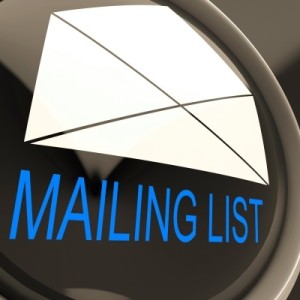
Image courtesy of Stuart Miles / FreeDigitalPhotos.net
Webinars are an excellent marketing tool, allowing you to demonstrate your expertise while also collecting vast amounts of marketing information. Some of the best information you can generate from hosting your own webinar is a highly targeted email list.
Those attending your webinar are likely to be there because you are providing advice on a certain topic which they are currently experiencing problems with. Therefore, not only are you generating names and business contacts, but you are also finding out the current demand for your products.
There are several steps in generating the highly targeted email list.
1. The Content
To ensure the best results from your webinar, start with the content and title. You want to make sure your webinar is very specific as this can tell you exactly what those attending are looking for.
So if you provide social media services, host a webinar which is entitled “How to Engage Your Followers on Social Media and Gain More Sales” rather than “How Best to Use Social Media”.
With a specific theme to your webinar you can determine what email content you should be sending to the audience.
2. The Sign-up Form
One of the first things you should look at is the sign-up form. You want to have a sign-up form to ensure that you aren’t going to be wasting time by not having anyone attend the webinar, but also to collect vital information on the attendees.
At the very least you should collect the following information:
- The name of the attendee.
- Their Email address.
- Their position in the business.
- The business they are from.
- Where their business is based.
- The nature of their business.
- The size of their business.
- Where they heard about the webinar.
Some of this information is part of your ‘qualifying practices’. You only want to talk to those decision makers who are in your target market. So if you have an attendee who is a marketing assistant from a company, they are unlikely to be the person to speak to about your products.
However, this doesn’t mean you shouldn’t let them listen to your webinar. They could listen to the webinar and then report back to their manager – who is a decision maker. Anyone who is perhaps not part of your target audience should still be added to a subscription list. This is because, although they might not buy from you, they could share the information on their social media channels which might be viewed by someone who would be.
The best action to take is to look over the attendees and highlight those who are of specific interest to your business.
3. During The Webinar
This is often missed off by webinar hosts who get caught up in the excitement or the process of hosting the webinar. Yet during the podcast your attendees will give you insight on who is ready to engage further with your brand. Watch out for those who are asking more questions and note down their names.
Once you have a list of their names, you can cross reference this with the initial high-priority attendee list from the sign-up form.
4. After The Webinar
Once the webinar has finished you should send a feedback form to your attendees. This should be a non-intrusive form which is fairly simple and quick to complete. Note who sends you responses, this is another point of interaction and these people should be placed on the high-priority email list.
Once you have completed the webinar and received the information you can create highly targeted sales content for your emails and send them to your list. This will give your emails a better chance of conversion and a higher value, leading to improved revenue.
Take Action:
- Host a webinar and collect information on who is attending, who is engaging and what they are they interested in.
- Split the attendee’s emails into two categories: those of special interest and those not of special interest.
- Then follow up the webinar with a highly targeted email campaign.
Read post Post a Comment. Tagged in: email list, email lists, email marketing, Opt-ins, Small Business
5 More Small Businesses With Great Email Opt-Ins
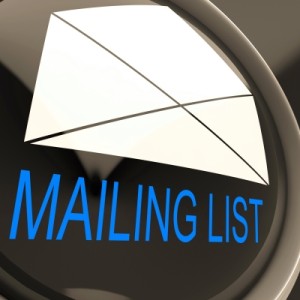
“Image courtesy of Stuart Miles / FreeDigitalPhotos.net”
There are many examples of email opt-ins available on the web. We have previously listed a few websites with great sign up areas for visitors. Today we go back to this topic and find some more excellent email opt-ins for you to take a look at.
1. motoring.au.com
Very clear and simple, this email opt-in appears on the first page of the website. It informs the reader exactly what they will receive if they sign up to the email newsletter (car news, reviews and advice). The website also draws attention to the button to process the visitor’s details which is in red and very eye catching.
The sign up also gives some peer pressure by showing how many people have liked their Facebook page and how many follow them on Twitter. When seeing this, others will want to join in where thousands of have before.
2. QuiBids
Although probably not the best positioned sign up, being at the bottom of a very long page, the bright colours against a white background do allow the sign up form to standout. In a similar vein the use of red in the heading draws the reader’s eye to this section of the website.
The details requested on the sign-up form are also not too obtrusive. Though what is really impressive is the offer they give you when you sign up. New sign ups get three free bids. Although this is probably something which they give all new users, it makes the visitor feel special.
3. Seek
Moving into the job market is our next website. Seek offers those who are registered or not, to have a regular email sent to their inbox about the latest jobs tailored to their requirements. There are several things which are good about this email opt-in. The first is that the content of the email is fully customisable, allowing the visitor to select only the information they are looking for.
Then the user can select the amount of jobs they receive by selecting the type of email they have (i.e. with or without graphics). The opt-in also allows the visitors to say whether they wish to be included for job searching advice and tips in their emails.
4. Forbes
This article site has many features with additional options for those who opt-in. This is made easy by the limited information required for the user to sign up with and therefore there is less chance of abandonment on the form.
There is also the option for the visitor to sign up using any one of their social media profiles – providing visitors easy access. Signing up to their email list allows special access to users and allows them to comment on articles which have been posted by their many contributors. This gives members a sense of community.
5. Business Insider, Australia
Business Insider offers those who wish to opt-in to their emails the choice of up to five different emails to receive. Individuals can select each one they wish to get and then enter in the minimal amount of information.
Once the visitor has signed up for the newsletter(s) they can then leave comments on any article. What is more interesting about this site is that they aren’t sending out the newsletters yet. They acknowledge this and explain they are generating a list to email before they commit to the publishing of a newsletter. However, they do announce exactly what the newsletters will contain.
So this a great example for building up your mailing list organically before jumping in with the mailing. This is a good idea if you are just starting out with email marketing and want to ensure you have significant numbers to make the process worthwhile.
There are loads of businesses out there with excellent email opt-in. By optimising your email sign up page you can generate more names on your mailing list and greater revenue for every email you write.
Take Action:
- Have a look at the above examples and see if you can incorporate any of their great ideas within your email marketing strategy.
Read post Post a Comment. Tagged in: email list, email list growth, email lists, email marketing, email opt-in
Social Media vs. Email Marketing For Small Businesses

Image courtesy of Stuart Miles / FreeDigitalPhotos.net
It is often the biggest asked question of whether social media or email marketing is better for small businesses. Both are very active marketing formats and both have their advantages, yet neither is the perfect solution alone.
Let’s explore both concepts and make a determination on how each one should be used in the online marketing of your products and services.
Social Media Marketing
Social media marketing has been one of the hottest new marketing methods which online marketing professionals have been utilising for a while now.
Social media has a great potential for gaining awareness of a brand. In fact a number of studies have shown that consumers enjoy and actively seek out information about new brands through Twitter, Facebook, etc.
Some consumers have even stated that they would not buy from a company that had no social media footprint at all.
However, social media alone cannot be relied upon. A study in 2012, found that of 77,000 online purchases, less than 1% could be contributed to social media marketing.
The fact is that even though people are looking for you on social media, they are looking for information, content and engagement. They are not looking for sale links or speeches. Therefore small businesses should be cautious in this approach.
Email Marketing
Email marketing is a staple of online marketing. In fact the first email sent for marketing purposes was sent in 1978, when Thuerk decided to send an email promoting DEC machines to 400 users of their network. Things have changed significantly since then.
Now email marketing is very common and instead of marketing just products or services, it can take many different forms.
Getting a list of contacts is also harder than it has been in the past. Individuals are likely to change their email address several times and addresses are more unique and customisable. It is also a very different legal landscape than it was before. There are now laws governing what an email should contain and how you can gather the names for your campaigns.
The only way people will join a mailing list is if they sign up to it, which means they must first find your email sign up page.
That being said though, email is not an ineffective method of marketing. According to the same Forrester report mentioned earlier, email marketing generated 13% of sales from those customers who had previously interacted with other forms of marketing; this was the second most popular purchasing path.
Therefore once you have attracted them to your newsletter and sent them an email, there is a good chance they will buy a product or service from you.
Conclusion
It is tough for email marketing as it is a great sales avenue but it cannot auto-generate a list effectively.
On the other hand, social media is not a great sales avenue but is really good for being discovered by consumers.
Therefore, instead of your business questioning which one is best for you, you should consider how you can integrate the two marketing approaches so they can work together. So consider that you attract your audience with your social media campaigns and direct them to methods in which they can sign up to your newsletter.
Once they have signed up to your email list, you can then introduce them slowly to your products and see how you can produce a steady stream of highly engaged consumers who know both your social media and newsletters.
Take Action:
- Start integrating your social media and email marketing campaigns into a single marketing process.
How do you integrate social media and email marketing? What have your results been?
Let us know in the comments below:
Read post Post a Comment. Tagged in: email marketing, Online Marketing, Small Business, Social Media, Social Media marketing
How To Use Current Events From LinkedIn To Create Email Content
 Using current events in your marketing mix is an excellent method of developing content which will resonate with your audience. Current events are more likely to attract the attention of your audience and encourage them to read your emails.
Using current events in your marketing mix is an excellent method of developing content which will resonate with your audience. Current events are more likely to attract the attention of your audience and encourage them to read your emails.
‘Events’ don’t have to be about the latest news. It could be covering the most recent trends or the latest problems which your target audience are experiencing at the time.
Discovering what the current issues, trends or news is in your industry are, can be difficult in this fast moving world.
However there is an excellent tool out there which can support your content generation: LinkedIn.
LinkedIn Groups
LinkedIn is one of the best places to find content because part of the social media platform is essentially like a forum where users discuss what issues are affecting them. By joining these groups you can discover what is currently affecting their lives.
You may also be able to get some ideas for your content through direct messaging or through shared articles.
From there you could make a list of topics and do research on how you can solve those problems.
Quoting
If you are particularly social in the groups which you are a member of, you could contact those who have made interesting comments and request permission to use their words in your content. This could be particularly useful as a quoted comment in your content has more authority than if you simply write the text as if it is all from you.
This is also another method of marketing your brand and perhaps having more signatories to your email newsletter and perhaps someone else who is willing to share your newsletter across their social media profiles because you have mentioned them.
Research
Another benefit of finding topics for discussion through LinkedIn is that the audience have probably already completed a lot of research for you. You should take what the group say with a pinch of salt, but there is a chance they would have shared articles or news items which back up what they say – therefore you can spend less time in researching the topic and give your content more authority.
You should include links to this research in your email marketing so your readers can see where you have collected the information from.
The Content
This style of email newsletter suits businesses which like to give very informative and highly valuable content. Essentially, the newsletter is a demonstration of your skills and expertise, offering a preview of the support or solutions you can provide your customers.
In your email you should ensure a story is told. There should be a set up of the problem, the solution and an idea which the audience can action themselves.
Make sure your audience can share the content socially with social media buttons and there is a link to either similar content on your blog or a related blog.
Further Benefits
If you post old versions of your email newsletters online, you can benefit additionally from the content because it is likely people will be using search engines to find articles on the topic you have written about. A good email should have a keyword density which can be easily indexed by the search engines on your website.
Conclusion
LinkedIn can be a fantastic resource for reaching out to your customer base, as long as you use the information it provides to its full potential. The information it can provide is reliable, timely and relevant to your audience and therefore they will enjoy reading and interacting with your email content.
Take Action:
- Have a look on LinkedIn and use some of the conversations you read for your next email newsletter
Do you use social media for conversation generation?
Let us know in the comments below.
“Image courtesy of cooldesigns / FreeDigitalPhotos.net”
Read post Post a Comment. Tagged in: email marketing, Email Newsletters, Email Strategy, LinkedIn, Social Media
When Should You Remove Subscribers From Your Email List?

How long until you delete old mailing contacts
The question is often asked of when you should remove members off your email marketing list. It is an interesting question.
Email marketing lists are sometimes viewed with pride by the number of addresses you have. This has at times led to business leaders going out and buying email lists. There are many articles out there that will advise against this. A bought list can ruin your marketing opportunity as your mail will get reported as spam, be blocked and essentially your reputation will be hurt.
Although old subscribers are unlikely to report your mail as spam – they are a potential problem. Having too many contacts on your database can slow down the delivery rate of your emails to those who are interested in hearing from you and generally no matter which service you use – more email recipients will often mean more money.
Also a group of people with inactive accounts or who simply delete everything in their email inbox will distort your statistics. This will make it harder for you to determine whether or not your campaigns are working.
So to save costs and be more efficient in your email campaigns you should enforce a strict removal policy. But the question is open as to how long you should wait until you remove someone from your mailing list.
There are many points of view on this but there are probably a few key activities (or lack thereof) which should be good indicators to show when you should do this:
1. They’ve requested it
Sometimes people don’t realise that they can simply click on an unsubscribe button on your email to remove their names from your emailing list or something has gone wrong before and it didn’t work.
Therefore, if someone does send you an email requesting that you remove them from your list – the person in charge of the list should do so immediately.
2. You’ve been in regular contact with them before
Sometimes client – business relationships do not work out. There can be many reasons for this and neither party may be at fault. However, if this does happen it is highly unlikely that your old client is likely to want to hear from you on a regular basis. Therefore the best option would be to remove them from your mailing list. If they do want to keep in contact they can always re-subscribe.
3. They regularly bounce
If you have people on your email list who regularly soft bounce the emails you are sending them it could be an indication they are not looking in their email account anymore. This is not a wonder, 17% of Americans create a new email address every 6 months – therefore if they’re regularly bouncing it might be they have moved on from that address.
4. They hard bounce
Hard bounces are impossible to turn around. If you find that an email address is hard bouncing the emails you are sending, it is best that you cut your losses and delete the contact from your email list.
5. After a year of not opening your email
If you have been sending content regularly to an email address and they are not opening your email for a significant amount of time, then you should consider deleting them from the email list.
Not opening your email is a sign they are no longer interested in what you have to offer. The amount of time which passes before this happens is open for debate depending on your industry and how many emails you send out to your list.
However, the general rule of thumb is about one year.
Conclusion
Your email list is not about how many contacts you have on the list, but the quality of those contacts. By having a list of highly engaged contacts you can ensure the financial efficiency and strong reputation of your brand in your email marketing campaigns.
Take Action:
- Come up with a group of reasons to delete contacts from your email list.
- Go through your list and see if any contacts should be removed.
When do you remove subscribers from your emailing list?
Let us know in the comments below.
Image courtesy of Stuart Miles / FreeDigitalPhotos.net
Read post Post a Comment. Tagged in: email list, email lists, email marketing, Email Strategy, email subscribers
7 Small Businesses With Great Email Opt-In Areas On Their Website
Having a great email opt-in doesn’t need to be as creative as you would think. There are a number of businesses out there who have excellent opt-in areas on their websites.
It is not just those who do well in the field of newsletters who use great methods to sign up for regular contact. This list of companies covers a range of different organisations in various industries.
Here are just a few of the best:

1. Fairfax Media
Fairfax media is a publication subscription company with a number of different physical and digital publications. Their digital publications are particularly good as they describe exactly what you will receive with each edition and give an example of what it will look like.
Their sign up process is easy, just requiring a name and email address and by giving their visitors a taste of what they can expect – this really does
2. First Digital
An online marketing agency – this company provides significant value when signing up to their newsletter by offering subscribers a chance to download a number of reports. The reports include useful documents such as social media case studies and search engine marketing support.
There is also an option where you can receive these reports without signing up to the newsletter.
3. The Warehouse
As soon as you log onto their website you are given the choice to sign up to their newsletter in a pop-up window. This gives users instant access to free information, the latest offers on the site and products available.
The only information that is required is your email address – giving visitors a quick and easy way to sign-up.
4. Grab a Seat
This organisation promises its users the very cheapest in airline seats. Their newsletter continues on with this promise by providing a guarantee that by signing up to the newsletter you will receive the latest offers and even faster booking times.
Their form requires a lot of information in order to sign up – however there is an option to use a Facebook account to auto-fill the information.
5. All Blacks Shop
Even the great national sporting team has a fantastic newsletter sign up at their website. Visitors are promised exclusive benefits and access to competitions, where they can win free products should they subscribe. The information to sign up is also pretty simple with just the email required.
The newsletter sign up is also very obvious on the front of the page – giving the sporting team more chance of converting readers into subscribers.
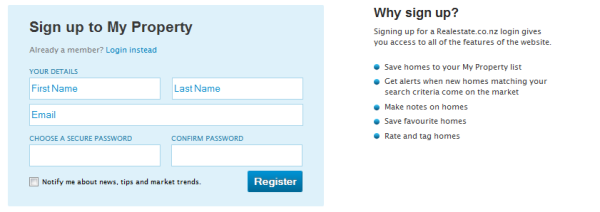
6. Real Estate
Real estate offers a host of benefits to those who sign up to their newsletter – including the ability to:
- Save homes to a property list.
- Receive alerts when a home matching their criteria is added to the site.
- Make notes on the homes on the database.
- Save your favourite homes on the site.
- Rate and tag homes on the database.
This is in addition to receiving the best tips, the latest news and trends in the market. Their sign up is quite simple with users only have to enter in a name, email and password. They also give users the chance not to receive the newsletter and just to sign up to the site.
7. Barfoot and Thompson
One of the biggest real estate companies in New Zealand is another in the industry with a great sign up list. This company doesn’t offer the same benefits as ‘Real Estate’ but it does have an easier sign up with only an email and a password required.
This site promises to send you the latest new properties and alerts about open houses in the area.
Take Action:
- Have a look through the websites above and see what style would suit your business best.
- Implement a really good opt-in page for your newsletters.
Conclusion
There are a number of organisations that offer various different ways to sign up for their newsletters. Each one is tailored for their audience – giving valuable content in exchange for the visitor’s details. What you need to do is apply the same thought pattern to boost the conversion of visitors to subscribers.
What offers do you have on your subscription page?
Let us know in the comments below:
Read post 1 Comment. Tagged in: email marketing, Opt-ins, sign up forms, Signups, Small Business